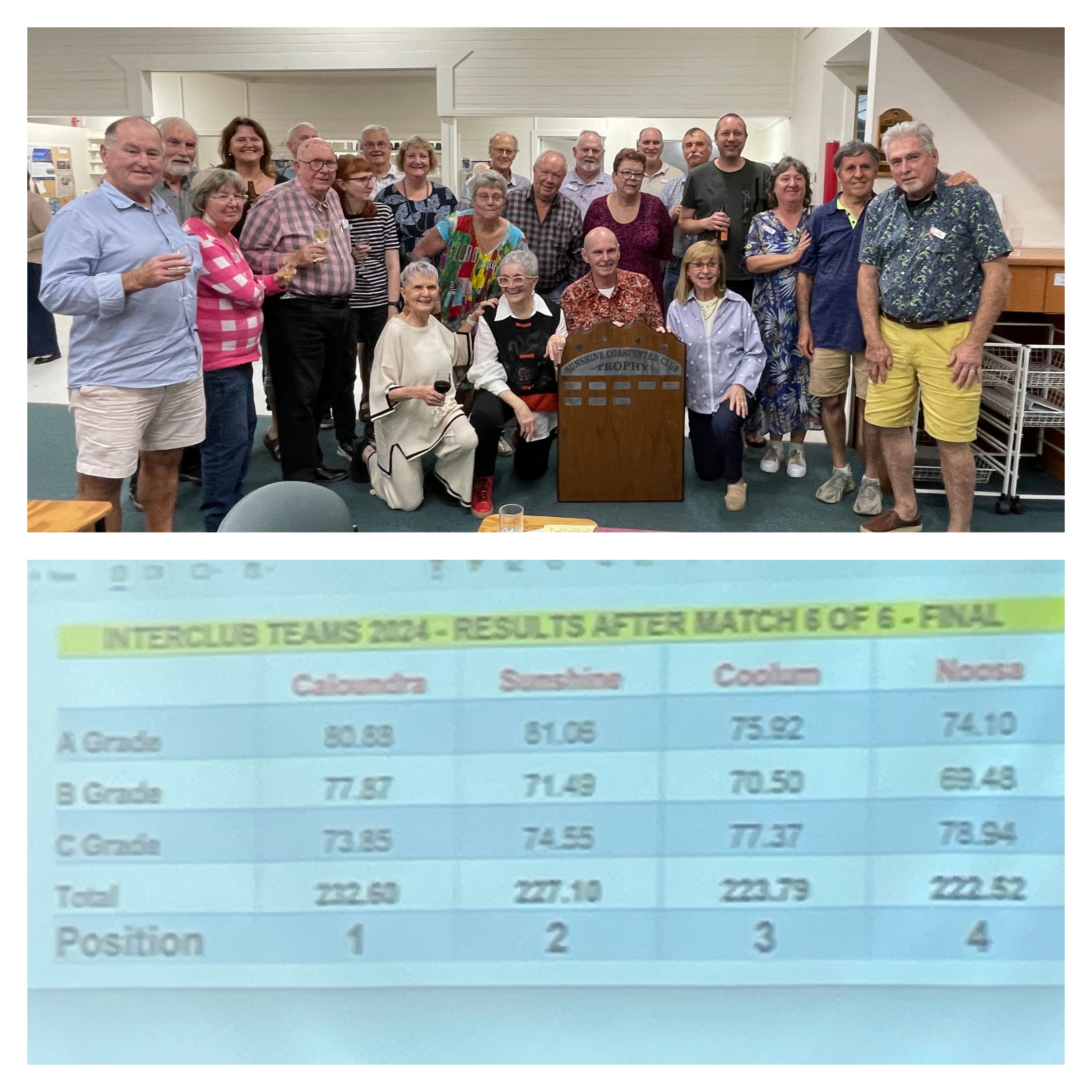 The Masters Bridge Lessons:
The Masters Bridge Lessons:
Commencing Tuesday 8th April at 9.15am two of NBC's very successful Masters, David Harris and Tim Ridley will be running lessons on "How to improve your bridge". To enrol please put your name on the list on the noticeboard near the front door.
Improvers System Card:
Please note if you have been involved with Susie Barlow's School of Bridge that an Improvers System card is now available on the NBC website. Go to Documents/Education to access and download. A Beginners System card compiled by John Gill is also available there.
Please Tell Your Friends:
Beginners lessons by John Gill commence on Monday 7th April at the club from 9.00-11.00am with Revision Play sessions commencing Tuesday 15th April from 12.30-2.30pm. The course runs over 8 weeks with a one week break over Easter. Cost is $80, please contact club admin by email or phone to enrol.
Hand for April:
The bridge hand for this month is a typical deal where both sides have their chances. As declarer you have to make the most of the opportunities presented by the defence in order to make your contract.
More...
Hands for March:
The Gold Coast Congress was held recently and produced some thought-provoking hands which were discussed each day in the Congress Bulletins. It is always interesting to compare different bidding styles, to see what contracts are possible.
More...
Hand for February:
Somerset Maughan was not only a talented playwright and novelist, but he also had a passion for bridge. In the hand highlighted this month Maughan shows us how to improve the 50-50 finesse to 70% by giving himself an extra chance and make his contract.
More...
Hand for January:
Another hand from Mike Lawrence who demonstrates once again the importance of playing correctly from trick one.
More...
Hand for December:
This month we look at two hands taken from the bridge column in The Australian and copied with kind permission from Paul Marston. The hands were played at prestigious events recently and feature some interesting bidding.
More...
Hand for November:
The hand this month is one that was played in the 1982 World Pairs Championship. The success of this contract would determine which pair would win the gold medal. The take home message is how important it is to trust partner!
More...
Hand for October:
The hand this month is titled "so near and yet so far". How can you reach dummy to use your winners?
More...
Hand of the Week:
The hand this week demonstrates how to use a Double Squeeze. This is a play in which both opponents are squeezed, and the two squeezes result in the gain of one trick. This hand is particularly satisfactory as you can claim the last trick with the two of clubs, the lowest card in the deck!
More...
Tip of the Week:
The tip this week is simple, but important, as there are a few things to think about before asking for aces, or key cards on the way to bidding a slam.
More...
Hand of the Week:
After bidding to slam Mike Lawrence demonstrates how to make 12 tricks with this hand, and as always, the winning play happens at trick one!
More...
Tip of the Week:
Another bridge chestnut from our grand master Ken, who suggests there are no bad 6-6 hands. The question is, how do we bid them?
More...
Hand of the Week:
Do you know where the term "Moysian Fit" comes from? The hand this week features brilliant defence by Alphonse "Sonny" Moyse Jnr who is a famous bridge personality of an earlier era. Sonny is remembered for many reasons, the main one being his insistence on the virtues of playing in a 4-3 trump fit.
More...
Tip of the Week:
This weeks' tip was suggested by our teacher John Gill and is titled the Lightner Double. This strange sounding double is when partner doubles the opponents slam contract, directing you to chose an unusual opening lead. As always, there are clues!
More...
Hand of the Week:
This hand is all about giving yourself every possible chance to make your contract. You find yourself in 6H with two possible losers, so how do you work out which suit to attack first?
More...
Tip of the Week:
A very important bridge chestnut from Ken Dawson this week, titled "Don't get in a tug o war with partner"!
More...
Hand of the Week:
The hand this week is taken from one played at the Gold Coast Congress in February, and shows how important it is to be aware of partners signal.
More...
Tip of the Week:
With fewer than 12 HCP there are opportunities to open the bidding and get the upper hand on our opponents. The Rule of 20 is one way we all know to evaluate a bridge hand but this has a few disadvantages and several authors recommend a few adjustments. The Rule of 22 is considered more reliable.
More...
Hand of the Week:
The hand this week is another courtesy of Mike Lawrence and describes how effective it can be to interfere over a strong 2C opening by opponents. In this hand the 2C opener had to describe his hand at the 5 level.
More...
Tip of the Week:
This is something we have talked about before - often when you are playing a hand you are anxious to keep a particular defender out of the lead - either because he has established cards in a suit , or could lead through one of your honours. This tip discusses two simple techniques that may help.
More...
Hand of the Week:
In this hand we can see the avoidance play technique in action.
More...
Tip of the Week:
Do you like leading from a doubleton? On some occasions it may be the best choice, but how will partner know whether it is a doubleton or a singleton?
More...
Hand of the Week:
As declarer there are a number of difficult decisions to make, it helps to know the percentages when you have choices to make....should you hope the clubs break 3-3, or try the diamond finesse?
More...
Tip of the Week:
Thanks to John Gill for supplying the tip for this week. It is about judging when to bid " three over three" in a competitive auction.
More...
Hand of the Week:
The hand this week is another courtesy of Mike Lawrence and is titled "Where am I". Here he emphasises the importance of leading from the right hand from trick one, how we need to look at all 13 tricks when we make our plan.
More...
Tip of the Week:
Another interesting Bridge Chestnut from Ken Dawson, who suggests that when the opposition sacrifice, then a pass in the immediate seat is forcing. This means that in a competitive auction, a pass allows partner to choose the most profitable action, whether it be to bid one more or to double.
More...
Hand of the Week:
Another bridge hand that demonstrates how clever defence can defeat a contract. Not many players would take the time to work out the distribution of declarer's cards, plus have the courage of their convictions to carry out their plan!
More...
Tip of the Week:
The theme this week is about when, how and why to make a Safety Play as declarer.
More...
Hand of the Week:
Continuing with our "safety play" theme we have a few hands to see this technique in action.
More...
Tip of the Week:
What is the most difficult skill to master in bridge? To a beginner it may be the finesse, a more experienced player may say executing endplays, coups or squeezes. These occur infrequently, a skill that comes up many times during a session, and
critical to our results is making a good opening lead.
More...
Hand of the Week:
Another insightful hand courtesy of Mike Lawrence, he suggests that if you are declarer and do your thinking at trick two, you are doing it too late!
More...
Tip of the Week:
This is the last in our series of different ways to finesse, and is the Backwards Finesse. This is just a simple finesse taken in the opposite direction, when you have worked out which opponent holds the honour card you need.
More...
Tip of the Week:
When missing two honours try the double finesse. Here you hope to lose only one trick by playing your LHO for one or both missing honours.
More...
Hand of the Week:
An excellent defensive play by the "Grand Old Man" of NZ bridge, Bruce Bell. An entry to partner's hand was needed to defeat the contract and Bruce Bell found the only way.
More...
Tip of the Week:
The Chinese Finesse is neither Chinese nor a finesse and has a small chance of succeeding based on the actual card layout. The deceptive play depends on the defender's confusion of partner's holdings, and a non winning trick may "slide by".
More...
Hand of the Week:
An important concept of declarer play is that of the "Danger Hand", the opponent who can do the most damage to us. The hand this week describes how to use this information to keep this opponent off lead.
More...
Tip of the Week:
Continuing our series on different types of finesses, this week we have the two-way finesse where either defender may have the elusive queen.
More...
Hand of the Week:
Another hand courtesy of Mike Lawrence where the defence has a good chance to defeat the contract, and as often happens a snap decision by the defence proves to be the incorrect one!
More...
Tip of the Week:
The term Coup en Passant is French for coup "in passing", in bridge terms it is a technique where trump tricks are "stolen" after the player who has the higher trump(s), in other words a trump promotion play.
More...
Hand of the Week:
Tip No 33 last year was on inferences gained by the opening lead and in the hand this week declarer uses inferences from the bidding and opening lead to make a slam.
More...
Tip of the Week:
The Tip this week describes the "ruffing finesse". This technique is used when you don't have enough trumps in dummy to ruff all your losers and you need to establish winners in a side suit.
More...
Hand of the Week:
This hand is a difficult 3NT where you need to establish one more trick to make your contract. Should you try the finesse straight away or is there a better play?
More...
Tip of the Week:
You are sitting quietly admiring your very nice hand when RHO opens 3S!How annoying! The idea of the preempt is to make life difficult and to make you guess, to get good results your partnership must have a system in place that you have both studied, discussed and agreed upon.
More...
Hand of the Week:
This hand has to deal with a preempt by the opponents but clever bidding found a 7D contract. American bridge guru Mike Lawrence describes the bidding and play in an insightful and entertaining article.
More...
Tip of the Week:
Another Q and A session. The topic is whether to over ruff, or not. A defender should not over ruff declarer or dummy automatically. The main consideration is the likelihood or otherwise of developing another trump trick.
More...
Hand of the Week:
We have two hands which describe the art of cross ruffing. There are a few
pre-requisites before embarking on a cross ruffing strategy, and as there is no plan B, it is important to get it right from the beginning.
More...
Tip of the Week:
In competitive bidding when you "bid one more" it should show an extra trump, not more points. Bidding one more shows extra length, not strength. Thank you Ken for another helpful bridge "chestnut".
More...
Hand of the Week:
As Adam mentioned yesterday , the World Team Bridge Championships have ended with a win to Switzerland, a very close finish with 167 to 164 by the Netherlands Team.
The hands this week feature some interesting boards played by our Australian Team competing against USA2.
More...
Tip of the Week:
Michaels is a cue-bid that promises a two suiter hand and the tip this week shows a Michaels Cue-bid in action.
More...
Tip of the Week:
Another bridge "chestnut" from Ken. This one is titled "sacrifice bids are over rated", and Ken explains why.
More...
Hand of the Week:
This hand is another example of how good defence can defeat a contract. The actual hand was played in the 1967 World Championships when the North American team defeated the team from Thailand.
More...
Tip of the Week:
The tip this week is in a different format, as you are presented with a few defensive dilemmas to solve, questions and answers.
More...
Hand of the Week:
Another hand from bridge author and teacher Michael Lawrence who demonstrates how to avoid taking a finesse when playing in a small slam.
More...
Tip of the Week:
When we are on opening lead against a slam contract it is extremely important to get off to a good lead. We are not going to be on lead very often so we must find the right action now! Ken Dawson gives his insights as to whether we should lead our unsupported Ace.
More...
Hand of the Week:
Another hand on good defence from the Gold Coast Congress, designed to show the thought process required to recover from an unfortunate opening lead.
More...
Tip of the Week:
We all know we need to count our losers as declarer, the tip today is for our beginners and talks about recognising the difference between fast losers and slow losers.
More...
Hand of the Week:
The hand this week comes from the Gold Coast Congress and was described as an example of how good defence can defeat the contract.
More...
Tip of the Week:
The tip this week is another "chestnut" from guru Ken Dawson and is titled " a flat hand is good for nothing". A 4-3-3-3 shape has no long suit for trumps or to run in no trumps, therefore you may need to downgrade such a hand.
More...
Hand of the Week:
Michael Lawrence titled this hand "take your only chance" and shows how to make a slam even after the opponents found a killing opening lead.
More...
Tip of the Week:
After our lesson from Andy Hung we are all looking for " killing opening leads", but it is never easy. When faced with an opening lead from a short suit against a no trump contract prefer an unbid major to an unbid minor.
More...
Hand of the Week:
This "monster' hand was played at the club last week and caused a few problems and many discussions, the only agreement reached was that there was no easy solution!
More...
Hand of the Week:
Tip 33 talked about paying attention to inferences from opening leads and cards chosen by declarer. This hand comes from the Gold Coast Congress and discusses how to gain information from a declarers unusual line of play.
More...
Tip of the Week:
When cashing winners in a suit there is a correct order in which to play. Non touching honours in the same suit need to be handled carefully.
More...
Tip of the Week:
Last week we discussed reopening the bidding at the 2 level, this week's tip is about when not to.
More...
Hand of the Week:
When dummy has few entries, declarer must handle them with care and often the critical decision happens at trick one.
More...
Tip of the Week:
When the opponents have stopped in a part score at the 2 level, should you pass it out or bid? Two of a major is almost always a great score for them so don't let them play there if at all possible.
More...
Hand of the Week:
Now that you have mastered the Simple Squeeze technique from last week, this hand introduces another concept called Jettison Play. This is a solution to blocking problems and means throwing away high cards.
More...
Tip of the Week:
The bidding has gone pass / pass / pass and it is up to you whether to bid or pass the board out. To open in 4th seat it should be with the intention of getting a plus score, and the "rule of 15" is another hand evaluation method to help decide.
More...
Hand of the Week:
Our hand this week is to demonstrate the simple squeeze technique, when declarer leads a card that forces a defender to discard or unguard a winner. Many squeezes are automatic and we have probably all executed a squeeze without even knowing it by playing out a long suit, just a few rules to follow.
More...
Tip of the Week:
Another bridge "chestnut" from Ken, describing how important it is to maintain length with a suit in dummy.
More...
Hand of the Week:
Our theme this week is keeping length with dummy. When declarer starts to run a long suit it is always difficult to know what cards to discard , it is important to think ahead as indecision will often give declarer a clue as to what you hold in that suit.
More...
Hand of the Week:
Another example of active defence, when you can see a way to defeat the contract it is up to you to take charge.
More...
Tip of the Week:
It can be more attractive to have the stronger hand as declarer and the weaker hand as dummy, but the over-riding consideration is to be in the right contract. When you have a choice of two trump suits, prefer to play in the trump suit of the weaker hand.
More...
Tip of the Week:
The tip this week is about which card to play from a sequence of honours, the aim is to give partner the correct information.
More...
Hand of the Week:
The hand this week continues on a theme we have discussed before, the importance of counting. These hands demonstrate how important it is keep counting HCP throughout the play of the hand.
More...
Tip for the New Year:
The object of the Alert system in bridge is for both pairs at the table to have equal access to all information contained in any auction. For our new players mixing with the "top guns" at the moment you must realise that bridge is not a game of secret messages, you can ask for an explanation....
More...
Christmas Tip:
The most important single skill any bridge player can possess is to be a good partner :)
Tip 36:
This week's tip is designed for our newer players. The aim of competitive bidding is to get the best possible score which may mean bidding on to go down - the goal is to work out how many tricks each side can make which is not just based on HCP but the number of combined trumps.
More...
Hand of the Week:
The hand this week requires a careful plan to succeed, set up your long suit before drawing trumps and hope the defenders cooperate!
More...
Tip 35:
At Sam's last lesson he described the Ace asking system Gerber CRO which created alot of interest so the tip this week is just a further explanation of Gerber CRO
More...
Hand of the Week:
With our theme being Gerber CRO this week, these are two hands designed to show the system in action.
More...
Tip 34:
Today's tip is called eight over eight, otherwise known at the Noosa Club as Rosies's Eights. It is designed to help work out whether to pass or bid one more when partner invites.
More...
Hand of the Week:
In Tip 11 we talked about the concept of endplay with a simple example. The hand this week shows us how to put the strategy into action.
More...
Tip 33:
Inference - An opinion reached based on known facts. So why did the opposition make that particular lead?
More...
Hand of the Week:
This hand follows on from the lesson by Andy Hung to show the value of active defence. A long suit in dummy where you are the only one that knows the finesse will work is a sign to take control.
More...
Tip 32:
"When in doubt, lead a trump" is an old guideline, but it is not always a good idea.
More...
Hand of the Week:
Following on with Tip 32, Michael Lawrence demonstrates how leading a trump contributes to defeating the opponents 2H contract.
More...
Hand of the Week:
Here we have another hand that emphasises the need to make a plan, as the order of play is critical..... if you have enough "natural" winners then draw trumps first otherwise it is important to think ahead and set up your long suit, ending in the correct hand.
More...
Tip 30:
Another bridge chestnut from Ken Dawson who states when missing QJxx and a top honour falls under your top honour then presume it is a singleton and play the opposition partner to have the other honour....this is the principle of Restricted Choice.
More...
Hand of the Week:
We have two hands this week that follow on from one of Sam's lessons, and highlight the importance of giving count to partner when there is a long suit in dummy.
More...
Tip 29:
For our new players : When you need to try a finesse, that is take a trick with a lower honour card you need to lead from the side opposite the lower honour card, think of leading from weakness towards strength. Plan ahead with few entries to dummy to take advantage of leading towards your strength.
More...
Hand of the Week:
Successful bridge players are committed to counting high card points, as declarer or defender. British author and bridge player Victor Mollo famously said " when I take a 50 - 50 chance I expect it to come off nine times out of ten"! These hands demonstrate the importance of counting HCP.
More...
Tip 28:
The 3 level pre-empt. Why do we pre-empt? No 1: Disruption and No 2: Description.
The next question is how do we respond to partners pre-empt....a few suggestions.
More...
Hand of the Week:
This weeks bridge hand talks about how to evaluate the playing strength of the hand, not counting points but counting how many tricks you might win including what partner has shown.
More...
Tip 27:
The tip this week is for our newer players and discusses the practice of reopening the bidding when the opponents are about to stop at a low level. This is where we "stretch" to keep the auction alive by "balancing" . A double in the pass out position is called a balancing double.
More...
Hand of the Week:
Is there a hidden trap to worry about? Which hand should you be in? Michael Lawrence demonstrates once again the need to make a plan from trick one. Michael also discusses yet another use for a double, the "irregular redouble".
More...
Interesting article in the Sydney Morning Herald:
This article was in the "Good Weekend" magazine and is very entertaining and worth a read
More...
Tip 26:
The Rule of 11 - Don't worry, this is not another complicated bridge rule but just a useful technique to help you decide which card to play in the opening round of a game.
More...
Hand of the Week:
The hand this week reiterates the suggestion made by John Gill in his sample hand a few months ago. The advice is we need to respond to a weak 2 bid by partner by raising the suit with trump support and " a scattering of points". The trump fit is critical not the points.
More...
Tip 25:
Bidding slams is not easy, but there is no doubt that bidding and making a slam is one of the great joys of bridge. The first important element in slam bidding is trying to identify when a slam might be on.
More...
Hand of the Week:
The hand this week is from Michael Lawrence and one he titled "how to steal from your opponents"
More...
Tip 24:
Another bridge chestnut from Ken. A change of suit by an unpassed responder is forcing....partner's hand is unlimited and opener must describe their hand further.
More...
Hand of the Week:
A tricky hand to play in 6S.....remember to stop after the opening lead is made, don't play to the first trick too quickly, count your losers and make a plan!
More...
Tip 23:
The perils of Misfitting Hands! Bridge hands are like stocks and shares, some go up in value and some go down according to the quality of your suits and the context of the auction. Bridge hands go DOWN in value once a misfit has been identified and you have to be extra careful.
More...
Hand of the Week:
We all know we need to make a plan.
This hand demonstrates how we can combine our chances to reduce losers and the importance of playing the cards in the right order to give ourselves the best chance to succeed.
More...
Hand of the Week:
Continuing with our theme on Defence, the hand this week comes from Michael Lawrence and demonstrates how important it is to identify declarer's potential plan in order to defeat the contract.
More...
Tip 22:
How to decide whether to use Passive or Aggressive tactics on defence? A few ideas to help the decision making.
More...
Tip 21:
The tip for this week is aimed at our newer players and is designed to help find the right game contract. When partner opens and you have enough points for game it is up to you to make sure you get there!
More...
Hand of the Week:
Today's hand suggests one way to respond to partners 1NT opening with a weak hand and both majors. Also discussed is one of Sam's suggestions on doubling an artificial bid to show length and strength in that suit and asking for that suit as an opening lead.
More...
Tip 20:
The tip for this week describes how to decide whether to double your opponents below game level. We all know you need length and strength in their suit but there are a couple of ways to work out whether the double is going to be profitable.
More...
Hand of the Week:
Todays hand confirms our Tip no 5 and discusses 2 boards where players bid too high, choosing to bid to the 5 level when they had already described their hand and partner was not interested, suggesting unless you are keen for partner to raise you to slam, double when the opponents bid 5 over 5.
More...
Hand of the Week:
Todays hand is one prepared for us by John Gill to demonstrate the importance of cutting out the opponents bidding space when partner opens with a weak bid.
More...
Tip 19:
This tip describes how to discard effectively when playing winners in trump contracts, discarding to make different shortages in the declarers and
dummys hands.
More...
Tip 18:
Another tip for our newer players. Interfering with the opponents 1NT opening is one of the best ways to get a good result and this article discusses a number of bidding systems to consider.
More...
Hand of the Week:
This hand demonstrates the trick winning ability of a 6-5 shape and discusses how to fully investigate by bidding a second suit as unbalanced hands belong in a suit contract not no trump.
More...
Tip 17:
Todays tip is a simple one and is all about the benefits of leading a trump when the opponents have made a sacrifice bid. Sacrifices are usually bid based on distribution so it is often vital to get in early and cut down their ruffing potential.
More...
Hand of the Week:
This hand comes courtesy of John Gill, and is reprinted with permission from a friend of Johns who analyses hands played in his Sydney Bridge Club. This week he discusses the advantage of letting the opposition play in 1NTX. A second hand is described which confirms one of Sam's doctrines!
More...
Hand of the Week:
Another hand from Michael Lawrence where the fate of the contract depends on the card played at trick one.
More...
Tip 16:
Todays Tip is titled "beware the singleton lead" and suggests drawing trumps first if you suspect the opposition is leading a singleton.
More...
Tip 15:
Tip no 7 caused a few discussions at the bridge club about the pros and cons of leading the top of partners suit. Michael Lawrence gives his insights into this "age old question" and clearly having a good partnership understanding is the solution.
More...
Hand of the Week:
This hand is printed with kind permission from Michael Lawrence, who is not only a bridge player, teacher and author but Michael has won 3 world titles.
Todays hand talks about the consequences of playing too fast, something we have all been guilty of.
More...
Hand of the Week:
Do you know how to bid with a "Swan"?
A swan is a 7-4 shaped hand. The saying is attributed to top Australasian player, Stephen Burgess. The hand is clearly lacking in defence to the unbid suits. This is why Burgess advocates an aggressive pre-empt straight to game.
More...
Tip 14:
When playing in a suit contract do you prefer to play in a 4-4 fit or 5-3?
Most bridge players prefer the 4-4 fit, do you know why?
More...
Tip 13:
This Tip is titled "but partner I only had 4 points!". Hand Evaluation is much more than just counting points and we can take advice from bridge experts Ron Klinger and Larry Cohen to learn how to use good judgement to value our bridge hands.
More...
Hand of the Week:
This is another hand demonstrating the value in establishing a long, side suit before leading trumps to enable the contract to be made.
More...
Tip 12:
Another Bridge Chestnut from Ken....should you always play second hand low?
More...
Hand of the Week:
Now we are in lockdown try this hand instead! Would you have been brave enough to bid the slam and would you have found the winning play?
More...
Hand of the Week:
You have ended in 7NT with an extraordinary hand of 36 hcp between you.
The jack of spades is led....try and make the contract before reading the solution.
More...
Tip 11:
Endplay - a fancy name for a simple idea. Sometimes it is better for one of the opponents to play a suit for you. Plan to lose a trick to the opponent you want to be on lead... one simple example of this technique
More...
Praise from Ken Dawson:
Thank you Ken for taking the time and effort to put together the attached article. All the novice and intermediate players have been working hard to improve their bridge play and it is very gratifying to be complimented by such a well respected player.
More...
Tip 10:
This tip is for our new players, some ideas on how to respond to partners opening bid
More...
Hand of the Week:
Todays' hand follows on from tip 10 and demonstrates another use for a double (X)
More...
Tip 9:
The opening lead is the one advantage defenders have over declarer, it provides a head start in our campaign to set up and cash tricks before declarer can do the same.....so when should you lead a singleton?
More...
Hand of the Week:
Thank you to John Gill for this hand that highlights the need to make a plan for declarer and defender
More...
Tip 8:
If you win the first trick as 3rd hand (behind dummy) do you always return partners lead?
More...
Hand of the Week:
Continuing on the theme of Tip 8 , when to return partner's opening lead ...see how to gather all the information available to make the right choice
More...
Tip 7:
Another "chestnut" from Ken: should you always lead top of partners suit?
More...
Hand of the Week:
This challenging hand demonstrates the importance of planning ahead, establishing a side suit to enable the contract to be made
More...
Tip 6:
Thank you to Ken Dawson from Coolum for sharing his expertise....should you always cover an honour with an honour?
More...
Hand of the Week:
An interesting bidding sequence.
How would you bid this to find the grand slam?
Thank you John Gill for this hand.
More...
Hand of the Week:
This interesting hand comes from the first round of the Noosa Championship Pairs
More...
Tip 5:
The Rule of 5 over 5 : when the bidding has reached the 5 level in a competitive auction it is generally better to defend than bid on.
The more balanced your hand, the less attractive it is to bid on.
Tip 3(defend at the 3 level)and Tip 5(defend at the 5 level) summed up by defend on odd occasions!
Hand of the Week:
Test Your Declarer Play....
More...
Tip 4:
The principle of fast arrival states that when you have a strong hand and want to have a conversation with your partner you bid slowly to conserve bidding space.
Conversely when you are weak you should bid FAST to remove bidding space from your opponents.
Hand of the Week:
Thank you to John Gill for supplying this interesting hand
More...
Tip 3:
The Rule of 3-over-3...if the bidding has reached the 3 level on a competitive part score deal, choose to defend unless you know your side has at least a 9 card fit...or if you have a clear strength advantage such as 23 HCP v 17
Tip 2:
This suggestion came from Sam's lesson on Wednesday.... when the bidding has gone pass/pass ( ie partner has passed) and you have 15 pts and a 5 card major, it may be better to open 1 of the major rather than 1NT.....The contract may be safer in a suit rather than no trump, with a 5/3 fit
Hand of the week:
This famous bridge hand demonstrates the strange things that can happen in a game of bridge.
Ian Fleming supposedly got his idea for his bridge game in the movie "Moonraker" from another famous match played by the Duke of Cumberland in the 19th century
More...
Bridge Probabilities for a Nine Card Suit:
The standard advice is eight ever, nine never...but should you play for the drop or try the finesse?
More...
Tip of the day...Lead inferences:
If partner doesn't lead your suit, assume partner:
1 is void
2 is leading a singleton
3 is leading top of a sequence
4 has the ace and fears declarer has the king
5 has fallen asleep











 The Masters Bridge Lessons:
Commencing Tuesday 8th April at 9.15am two of NBC's very successful Masters, David Harris and Tim Ridley will be running lessons on "How to improve your bridge". To enrol please put your name on the list on the noticeboard near the front door.
The Masters Bridge Lessons:
Commencing Tuesday 8th April at 9.15am two of NBC's very successful Masters, David Harris and Tim Ridley will be running lessons on "How to improve your bridge". To enrol please put your name on the list on the noticeboard near the front door.
 Thursday 8 May 2025
Thursday 8 May 2025
 Wednesday 28 May 2025
Wednesday 28 May 2025
 Thursday 19 June 2025
Thursday 19 June 2025
 Another successful President's Cup event was held last Monday with involvement of members across the board. The ultimate N-S and E-W winners were David & Susanne Sarten and Lizzie Van Vugt & Julie Scott. Congratulations to all.
[posted Fri 21-Mar-25]
Another successful President's Cup event was held last Monday with involvement of members across the board. The ultimate N-S and E-W winners were David & Susanne Sarten and Lizzie Van Vugt & Julie Scott. Congratulations to all.
[posted Fri 21-Mar-25] This trio of NBC club members celebrated a birthday and two impending birthdays at the Saturday bridge session. The 237 years denotes life not bridge experience (I think). We all know of Gayna's fishing prowess and of Hilary's meanderings through the Tanami Desert but what of the enigmatic Grace?
[posted Mon 17-Mar-25]
This trio of NBC club members celebrated a birthday and two impending birthdays at the Saturday bridge session. The 237 years denotes life not bridge experience (I think). We all know of Gayna's fishing prowess and of Hilary's meanderings through the Tanami Desert but what of the enigmatic Grace?
[posted Mon 17-Mar-25] In the B Division it was all NBC, well almost. First were the Scott Team of Gary & Debbie Gibbards (Caboolture) and our own Lizzie Van Vugt and Julie Scott. Second were the Jadach Team of Anna Irminger, Peter Hagan, Anna Jadach and Eugenie Mooney with the Miller Team of Mark & Lorraine Miller, Hilary French and Grace Mathias in third place. The performance of all three teams was notable and is reflected by the fact that they played the top seeded 3 teams in the final round.
[posted Mon 3-Mar-25]
In the B Division it was all NBC, well almost. First were the Scott Team of Gary & Debbie Gibbards (Caboolture) and our own Lizzie Van Vugt and Julie Scott. Second were the Jadach Team of Anna Irminger, Peter Hagan, Anna Jadach and Eugenie Mooney with the Miller Team of Mark & Lorraine Miller, Hilary French and Grace Mathias in third place. The performance of all three teams was notable and is reflected by the fact that they played the top seeded 3 teams in the final round.
[posted Mon 3-Mar-25] Results are in for this event played over the weekend at NBC. First overall with a creditable 8 wins from 8 matches was the Magee Team of Terry Strong, Jill Magee, Therese Tully and Richard Ward. They kindly donated their Winners' Trophy pens to the 24th placed Heatley Team.
[posted Sun 2-Mar-25]
Results are in for this event played over the weekend at NBC. First overall with a creditable 8 wins from 8 matches was the Magee Team of Terry Strong, Jill Magee, Therese Tully and Richard Ward. They kindly donated their Winners' Trophy pens to the 24th placed Heatley Team.
[posted Sun 2-Mar-25] With almost half of our total membership in attendance this was an event fully enjoyed by all. To quote some What's App comments. "Jan and I can only speak for the last 24 Christmas Parties. Today was the best ever. Our congratulations and thanks to all who made it possible." Ed and Jan Beckett "Thanks everyone great day of bridge and fun. What a great bridge club we have, lucky we." Mike Stawski "Balthazar, Melchior and Casper the three wise Kings from the East thank all Santa's little helpers who make the NBC Christmas event so special!" Frank Farouk. Many other Christmas Party photos are currently being downloaded and can be accessed under the "Photos" heading.
[posted Fri 13-Dec-24]
With almost half of our total membership in attendance this was an event fully enjoyed by all. To quote some What's App comments. "Jan and I can only speak for the last 24 Christmas Parties. Today was the best ever. Our congratulations and thanks to all who made it possible." Ed and Jan Beckett "Thanks everyone great day of bridge and fun. What a great bridge club we have, lucky we." Mike Stawski "Balthazar, Melchior and Casper the three wise Kings from the East thank all Santa's little helpers who make the NBC Christmas event so special!" Frank Farouk. Many other Christmas Party photos are currently being downloaded and can be accessed under the "Photos" heading.
[posted Fri 13-Dec-24] Very deserved winners of best Christmas themed outfits were that mismatched couple "One of the Three Wise Men" aka King Farouk aka our own special Frank and "The Grinch" aka Michelle Behrens. For absolute style its hard to go past Maddie Nielsen and Anna Jadach although the eclectic outfit of Lizzie French also deserves a special mention. "Mrs Claus" aka Erika Gartner was also in attendance dispensing Christmas chocolates, as usual, to all her happy opponents.
[posted Fri 13-Dec-24]
Very deserved winners of best Christmas themed outfits were that mismatched couple "One of the Three Wise Men" aka King Farouk aka our own special Frank and "The Grinch" aka Michelle Behrens. For absolute style its hard to go past Maddie Nielsen and Anna Jadach although the eclectic outfit of Lizzie French also deserves a special mention. "Mrs Claus" aka Erika Gartner was also in attendance dispensing Christmas chocolates, as usual, to all her happy opponents.
[posted Fri 13-Dec-24] Apologies to those who missed the photo shoot but the thanks of all members go to all the volunteers who helped to make this such a great club in 2024. They include Dealers, Directors, Committee, Teachers, Michelle, Masterpoint compilers, Caddies, Kitchen helpers, Coffee Machine servicers and our newly appointed Handyman and other unnamed. A special thanks to Rosie Charles and Ann Coppard who made the Christmas Party such a wonderful event.
[posted Fri 13-Dec-24]
Apologies to those who missed the photo shoot but the thanks of all members go to all the volunteers who helped to make this such a great club in 2024. They include Dealers, Directors, Committee, Teachers, Michelle, Masterpoint compilers, Caddies, Kitchen helpers, Coffee Machine servicers and our newly appointed Handyman and other unnamed. A special thanks to Rosie Charles and Ann Coppard who made the Christmas Party such a wonderful event.
[posted Fri 13-Dec-24] Joint Noosa/Coolum club members featured in the recently concluded 2024 Coolum Pairs Championships. First overall for the second year in a row were Ann Mellings and Brett Middleberg while the team of Anna Irminger and Peter McNamee came a creditable third overall. Winners of the Intermediate Divison were Elizabeth Van Vugt and Maggie Murray and winners of the Novice Division were Ian Davis and Penny Roberts. Congratulations to all.
[posted Sun 24-Nov-24]
Joint Noosa/Coolum club members featured in the recently concluded 2024 Coolum Pairs Championships. First overall for the second year in a row were Ann Mellings and Brett Middleberg while the team of Anna Irminger and Peter McNamee came a creditable third overall. Winners of the Intermediate Divison were Elizabeth Van Vugt and Maggie Murray and winners of the Novice Division were Ian Davis and Penny Roberts. Congratulations to all.
[posted Sun 24-Nov-24] The Noosa Imp Pairs completed last Sunday rounded off a most successful year of events run by NBC. With 40 entrants of which a third came from other clubs it proved a wonderful event for all participants. Against some very challenging competition Rosie Green and Maureen Jakes came from behind in the last round to be the overall winners with Larry Moses and Nikolas Moore in second place. Winners in the B Division were Susie Barlow and Gayna Ryan with runners-up Lizzie Van Vugt and Julie Scott. Thanks as always to all the volunteers who made it such a successful day and to our Tournament Director.
[posted Mon 18-Nov-24]
The Noosa Imp Pairs completed last Sunday rounded off a most successful year of events run by NBC. With 40 entrants of which a third came from other clubs it proved a wonderful event for all participants. Against some very challenging competition Rosie Green and Maureen Jakes came from behind in the last round to be the overall winners with Larry Moses and Nikolas Moore in second place. Winners in the B Division were Susie Barlow and Gayna Ryan with runners-up Lizzie Van Vugt and Julie Scott. Thanks as always to all the volunteers who made it such a successful day and to our Tournament Director.
[posted Mon 18-Nov-24] The two-day Noosa Springs Pairs were completed yesterday. Winners in A Grade were Philippa Barnett and Lizzie French, with Rosemary Green and Tim Ridley second and Anna Irminger and Eugenie Moodie third. In B Grade the winners were Larraine McCaffrey and Jenny Mawson with Barb Allen and Beulah O''Shea second and Kathy Mitchell and Keith Caldwell third. Congratulations to Directors, event organisers and those volunteers that put on drinks and nibbles at the end of the event.
[posted Mon 28-Oct-24]
The two-day Noosa Springs Pairs were completed yesterday. Winners in A Grade were Philippa Barnett and Lizzie French, with Rosemary Green and Tim Ridley second and Anna Irminger and Eugenie Moodie third. In B Grade the winners were Larraine McCaffrey and Jenny Mawson with Barb Allen and Beulah O''Shea second and Kathy Mitchell and Keith Caldwell third. Congratulations to Directors, event organisers and those volunteers that put on drinks and nibbles at the end of the event.
[posted Mon 28-Oct-24] The 2024 Noosa Novice Pairs Congress was held yesterday and in organiser Joanne McCarthy's words it was a "Fabulous Fun Day". Big congratulations to the Lobb family with Persephone coming first overall with partner Kerry Rutter and Steve coming first in B Division with partner Jack Baynes. Is this the start of both a Lobb and Baynes dynasty at NBC. Many thanks to all the helpers who contributed to such a memorable day and as always to ever friendly Director Steve Murray. Photos were somewhat marred by a brightly clad photo bomber.
[posted Wed 16-Oct-24]
The 2024 Noosa Novice Pairs Congress was held yesterday and in organiser Joanne McCarthy's words it was a "Fabulous Fun Day". Big congratulations to the Lobb family with Persephone coming first overall with partner Kerry Rutter and Steve coming first in B Division with partner Jack Baynes. Is this the start of both a Lobb and Baynes dynasty at NBC. Many thanks to all the helpers who contributed to such a memorable day and as always to ever friendly Director Steve Murray. Photos were somewhat marred by a brightly clad photo bomber.
[posted Wed 16-Oct-24] Overall: First - Kerry Rutter and Persephone Lobb, Second - Greg Murray and Lorna O'Donnel, Third - Joanne McCarthy and Dave Reid, B Division: First - Jack Baynes and Steve Lobb.
Second - Ann Coppard and Ingrid Allen, Third - Trevor and Lin Stafford
[posted Wed 16-Oct-24]
Overall: First - Kerry Rutter and Persephone Lobb, Second - Greg Murray and Lorna O'Donnel, Third - Joanne McCarthy and Dave Reid, B Division: First - Jack Baynes and Steve Lobb.
Second - Ann Coppard and Ingrid Allen, Third - Trevor and Lin Stafford
[posted Wed 16-Oct-24] Another great event was hosted by NBC on Sunday 8th September with a total of 26 teams contesting the Noosa Spring Swiss Teams event, 14 of those teams travelling from other clubs to attend. The youthful Langdon Team comprising ABF Youth Club and Brisbane-based club members were worthy winners on the day. Special thanks to returning Congress Coordinator Joanne McCarthy and her wonderful gang of helpers and to Director Peter Busch.
Overall Winners the Langdon Team compromised Rachel Langdon, Seb Langdon Macmillan, Kate Macdonald and Nikolas Moore, 2nd were the Luck team and 3rd the Stoneman Team. In the B Division the winners were the Gibbards Team comprising Debbie and Gary Gibbards, Peter Gruythuysen and Ross Shardlow, 2nd the Nielsen Team and 3rd the Caldwell Team, the latter two teams carrying the flag for NBC in creditable performances
[posted Sun 8-Sep-24]
Another great event was hosted by NBC on Sunday 8th September with a total of 26 teams contesting the Noosa Spring Swiss Teams event, 14 of those teams travelling from other clubs to attend. The youthful Langdon Team comprising ABF Youth Club and Brisbane-based club members were worthy winners on the day. Special thanks to returning Congress Coordinator Joanne McCarthy and her wonderful gang of helpers and to Director Peter Busch.
Overall Winners the Langdon Team compromised Rachel Langdon, Seb Langdon Macmillan, Kate Macdonald and Nikolas Moore, 2nd were the Luck team and 3rd the Stoneman Team. In the B Division the winners were the Gibbards Team comprising Debbie and Gary Gibbards, Peter Gruythuysen and Ross Shardlow, 2nd the Nielsen Team and 3rd the Caldwell Team, the latter two teams carrying the flag for NBC in creditable performances
[posted Sun 8-Sep-24] Congratulations to first time winners Caloundra BC who were deserved victors in the 2024 Interclub Teams event played at NBC last Saturday. The four competing teams, Caloundra, Coolum, Sunshine Coast and Noosa were able to field multiple teams in all grades. Catering and organisation on the day were first class as usual and a fabulous day was had by all. Thanks to Director, Peter Busch and to the many organisers and volunteers who contributed their valued time and efforts. Noosa BC members are eagerly anticipating the 100km round trip to Caloundra next year to reclaim the trophy.
[posted Sun 18-Aug-24]
Congratulations to first time winners Caloundra BC who were deserved victors in the 2024 Interclub Teams event played at NBC last Saturday. The four competing teams, Caloundra, Coolum, Sunshine Coast and Noosa were able to field multiple teams in all grades. Catering and organisation on the day were first class as usual and a fabulous day was had by all. Thanks to Director, Peter Busch and to the many organisers and volunteers who contributed their valued time and efforts. Noosa BC members are eagerly anticipating the 100km round trip to Caloundra next year to reclaim the trophy.
[posted Sun 18-Aug-24] Susie Osmaston has done it again, revealing an absolute gem within our membership none other than that inveterate traveller, Deirdre Fitzgerald. A very down-to-earth lady that has brought credibility and humanity to the legal profession over a long and distinguished career. To many more cruises, Deirdre.
See more...
[posted Fri 16-Aug-24]
Susie Osmaston has done it again, revealing an absolute gem within our membership none other than that inveterate traveller, Deirdre Fitzgerald. A very down-to-earth lady that has brought credibility and humanity to the legal profession over a long and distinguished career. To many more cruises, Deirdre.
See more...
[posted Fri 16-Aug-24] The Annual Pro-Am event was held yesterday, thanks go to Rosie and her team for managing the pairings without fear or favour. It was arguably our best ever and is fast becoming the favourite annual event. Winners were: A-NS Judy Kitcher and Di Jones, A-EW John Gill and Rhonda Kingston, B-NS Peter King and June Drysdale, B-EW (equal first) Dave Reid and Genevieve Burke / Leisha McMenamin and Ann Coppard. Our VP may have got slightly carried away with her congratulations (see photo) and sincere apologies to Dave and Genevieve who due to oversight missed their prizes and photos. Selected Members comments; Gilly Hogarth "A really happy occasion and a very good way to get so many members of our happy club mixing"; Mike Stawski "Love Pro-Am event"; Barb Allen "What a fabulous afternoon.....it has left many members"abuzz"".
[posted Mon 12-Aug-24]
The Annual Pro-Am event was held yesterday, thanks go to Rosie and her team for managing the pairings without fear or favour. It was arguably our best ever and is fast becoming the favourite annual event. Winners were: A-NS Judy Kitcher and Di Jones, A-EW John Gill and Rhonda Kingston, B-NS Peter King and June Drysdale, B-EW (equal first) Dave Reid and Genevieve Burke / Leisha McMenamin and Ann Coppard. Our VP may have got slightly carried away with her congratulations (see photo) and sincere apologies to Dave and Genevieve who due to oversight missed their prizes and photos. Selected Members comments; Gilly Hogarth "A really happy occasion and a very good way to get so many members of our happy club mixing"; Mike Stawski "Love Pro-Am event"; Barb Allen "What a fabulous afternoon.....it has left many members"abuzz"".
[posted Mon 12-Aug-24] After a somewhat sluggish start to the tournament the Ridley team compromising five Grandmasters hit their straps on Day 3 and established a solid lead by mid-afternoon which they never relinquished. Congratulations to the Winners, Philippa Barnett, Rosie Green, David Harris, Maureen Jakes and Tim Ridley. Second was the Huddart team of Meredith Bunn, Michael Huddart, Leisha McMenamin and Jean Pearce and Third the Jones team of Di Jones, Anna Irminger, Lois Meldrum, Ann Mellings, Eugenie Mooney and Allison Walker. The Winners won by a clear 33 Imps but the closeness of the competion is reflected by the fact that 2nd to 7th placings were only separated by 21 Imps. Thanks go to all players and the myriad organisers and helpers who made it such a great event.
[posted Sat 27-Jul-24]
After a somewhat sluggish start to the tournament the Ridley team compromising five Grandmasters hit their straps on Day 3 and established a solid lead by mid-afternoon which they never relinquished. Congratulations to the Winners, Philippa Barnett, Rosie Green, David Harris, Maureen Jakes and Tim Ridley. Second was the Huddart team of Meredith Bunn, Michael Huddart, Leisha McMenamin and Jean Pearce and Third the Jones team of Di Jones, Anna Irminger, Lois Meldrum, Ann Mellings, Eugenie Mooney and Allison Walker. The Winners won by a clear 33 Imps but the closeness of the competion is reflected by the fact that 2nd to 7th placings were only separated by 21 Imps. Thanks go to all players and the myriad organisers and helpers who made it such a great event.
[posted Sat 27-Jul-24]
This event was run last Thursday with 40 competing pairs from around the Sunshine Coast.
What a wonderful day it was and thanks must go to all the volunteers (too many to mention) who ensured it was such a great event. Thanks to Peter Busch for running the event with his usual panache, to the last minute bar staff, Barb and Steve, who by the look of the photo, thoroughly enjoyed their duties and a very special mention for Supercaddy, Ron Jadach, who in a solo, all day effort, chalked up over 14,400 steps.
[posted Sat 22-Jun-24]
 First: Maureen Jakes and Michael Huddart
Second: Geoff Olsen and Adrienne Kelly
Third: Alison and Ken Dawson
[posted Sat 22-Jun-24]
First: Maureen Jakes and Michael Huddart
Second: Geoff Olsen and Adrienne Kelly
Third: Alison and Ken Dawson
[posted Sat 22-Jun-24] First: Gayna Ryan and Julie Scott
Second: Maureen Wright and Di Banks
Third: Susie Barlow and Helen Lawson
[posted Sat 22-Jun-24]
First: Gayna Ryan and Julie Scott
Second: Maureen Wright and Di Banks
Third: Susie Barlow and Helen Lawson
[posted Sat 22-Jun-24] First: Kerrie Rutter and Julia Caldwell
Second: Meredith Bunn and Joan Reeve
Third: Louise Ryan and Persephone Lobb
[posted Sat 22-Jun-24]
First: Kerrie Rutter and Julia Caldwell
Second: Meredith Bunn and Joan Reeve
Third: Louise Ryan and Persephone Lobb
[posted Sat 22-Jun-24] After an arduous 125 hands over 3 days and 4 sessions in which every pair played every other pair, we have deserved winners of the 2024 Pairs Championships in Maureen Jakes and Michael Huddart. In second place were David Harris and Tim Ridley followed closely in third place by Sheryl Cullenward and Ann Mellings. Congratulations to Organisers, Director Steve, Caterers, Caddies and all others who helped out and to all the players who contributed to a great event.
[posted Fri 17-May-24]
After an arduous 125 hands over 3 days and 4 sessions in which every pair played every other pair, we have deserved winners of the 2024 Pairs Championships in Maureen Jakes and Michael Huddart. In second place were David Harris and Tim Ridley followed closely in third place by Sheryl Cullenward and Ann Mellings. Congratulations to Organisers, Director Steve, Caterers, Caddies and all others who helped out and to all the players who contributed to a great event.
[posted Fri 17-May-24]